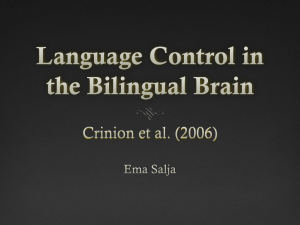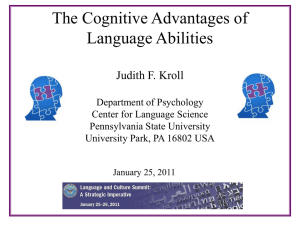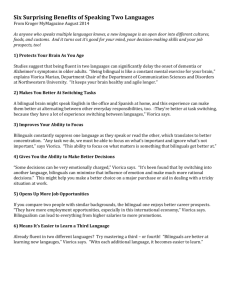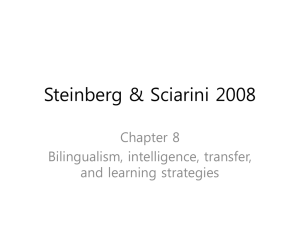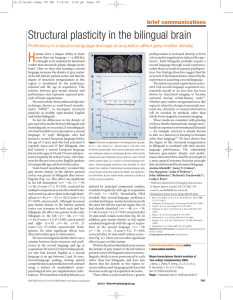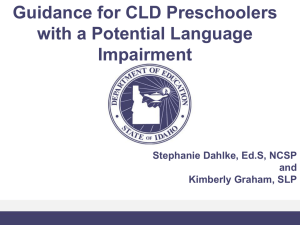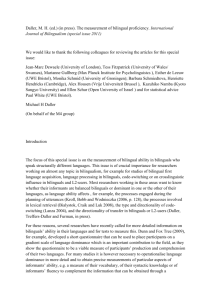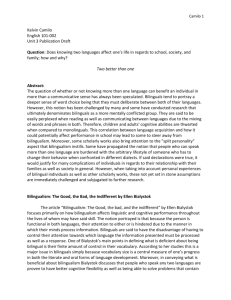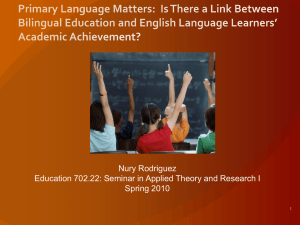EAGLE Student Mentoring PPT
advertisement
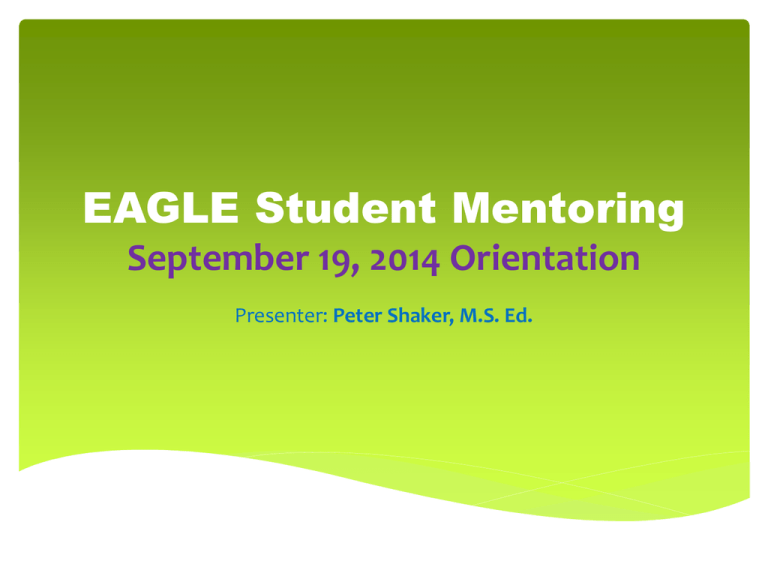
EAGLE Student Mentoring September 19, 2014 Orientation Presenter: Peter Shaker, M.S. Ed. Objectives: To gain an understanding of bilingual students To learn methods and strategies for working with ELL students To share experiences and effective techniques 2 The content of the following slides is from the following: LEARNING IN TWO LANGUAGES IN EARLY CHILDHOOD: WHAT EVERY EARLY CHILDHOOD PROFESSIONAL NEEDS TO KNOW Mileidis Gort, Ed.D. The Ohio State University Defining Bilingualism •Bilingualism is not only about proficiency in two languages •Bilingualism is about proficiency, use, and experience •Each language serves different purpose/s •Each language is used in different places, with different people •Each language is a different tool for a different job! Defining Bilinguals •Bilinguals know more than one language to different degrees and use these languages for a variety of purposes. •A bilingual child is … someone who is exposed to two languages no matter what her level of proficiency in either language. Types of Bilinguals Simultaneous bilinguals •Are exposed to two languages at very early age (from birth -3 years) •Have two native languages •Develop two separate, but connected linguistic systems Types of Bilinguals Sequential bilinguals •Learn one language first, then are introduced to a second language (after age 3) •Often have a home language that differs from the language of instruction at school Factors Influencing Bilingual Development Process •Quantity of input in La, Lb •Quality of input in La, Lb •Opportunity to use language/s in different contexts •Nature of language use in different contexts Factors Influencing Bilingual Development Process •Quantity of use and exposure to each language •Quality of language context and input in each language •Opportunity to use language/s across a variety of contexts Stages of Dual Language Learning: Simultaneous Bilinguals •Simultaneous bilingual children and monolingual children develop language in similar ways •Reach same milestones, at around the same ages •Growth in each language depends on exposure and experience Stages of Dual Language Learning: Simultaneous Bilinguals •First words emerge at around 12 months •Vocabulary includes words from each language •Use similar strategies to communicate •Over-extending the meaning of words (e.g., dog = any four legged animal), •Under-extending word meanings (e.g., dog = the family’s dog) •Two-word stage emerges at around 18 months •At 3-4 years, begin to produce longer and more complex sentences Stages of Dual Language Learning: Sequential Bilinguals STAGE 1: Home language (L1) use •Children draw on what they know •Attempt to use their home language to communicate Stages of Dual Language Learning: Sequential Bilinguals STAGE 2: Observation and listening period •Children appear to be in a “non-verbal” period •During this time, they collect data about the new language •They are listening, watching, and rehearsing quietly what they are learning Stages of Dual Language Learning: Sequential Bilinguals STAGE 3: Limited use of new language • Use telegraphic communication •Single words, very short phrases • Use formulaic phrases •Learn entire chunks of language/phrases •Don’t necessarily know what each component of phrase means Stages of Dual Language Learning: Sequential Bilinguals STAGE 4: Selected use of new language • Break up formulaic phrases into meaningful smaller pieces • Begin to build their own phrases, sentences with those pieces Stages of Dual Language Learning: Sequential Bilinguals STAGE 5:Fluid use of second language (L2) •With experience, exposure, support, and opportunity to use their new language, proficiency in new language grows BUT, there are individual differences in language learning and development! Language Learning “Errors” •Are a natural part of the language learning process •Show children’s meaning making and evolving understanding of language patterns •Represent strategies that learners use to create language • Provide evidence of progress in language competence Transfer: Influence of Other Language • Children’s linguistic knowledge is an important scaffold for additional language learning •Variations in linguistic patterns across languages leads to nonstandard language, or transfer “errors” –phonological influence -- “accent” –syntactic influence -- word order “the hat blue” vs. “the blue hat” •Evidence that bilingual children are using what they know and figuring out what works similarly and differently in each language Codemixing •The use of words or elements of words from two or more languages in conversation (or written language) … But, does this mean the child is confused??? Codemixing • A normal, natural aspect of bilingual acquisition (most bilinguals do it!) • A pragmatic, creative way to communicate as language systems still developing • NOT a sign of confusion, or inability to separate languages “I put the fork en la mesa.” “Quiero ir outside.” Summary of Typical Early Bilingual Development •Bilingualism does not cause language delays. •Bilingual children’s early vocabularies in each language tend to be smaller than those of monolinguals, but are comparable when combined. •Bilingual children follow a similar time line in development of morphology and syntax as monolingual children, but bilinguals might need more time to reach accuracy of use. •Bilingual children are not equally fluent in each language. Their language proficiencies change over time. • Proficiency is related to exposure and opportunity to use language/s. • Children use both developing languages as resources that support further development. • Codemixing is a typical bilingual behavior that supports communication and meaning-making. The content of the following slides is from the following: Effective Tier I Instruction for English Language Learners (ELLs) Two Types of Language •Conversational Language •Academic Language Source: Jim Cummins 23 Examples of Conversational vs. Academic Language Conversational: My idea is like ___’s idea. Academic: My idea is similar to ____’s idea. I agree with ______’s perspective. I also think that …. Stages of Second Language Acquisition Stage General Time Frame Characteristics Teacher prompts Pre-production 0-6 Months Student understands very little English. May be in silent period or only give one or two word responses. Show me.. Draw.. Point to… Early production 6 months – 1 year Student has limited understanding of English and produces 1 or two word responses. May understand more than he/she can express Yes or no questions Either/or questions Lists Labels Speech Emergence 1-3 years Student understands most conversational English, but not academic language and idioms. Can produce simple sentences, but makes grammar and pronunciation errors. Still has limited vocabulary. Why..? How..? Explain.. Short answer questions Intermediate Fluency and Advanced Fluency 3-5 years and 5-7 years Speaks in fluent sentences using standard grammar. May have difficulty understanding complex content area materials. Limited understanding of less commonly used words and subtleties in language. What do you think would happen if..? Why do you think..? How do you use L1 to build L2? 26 Prefixes, Suffixes, and Word Roots Layers of Language Other 5% Greek – 10% (Content area words) Latin - 60% (Content area words) Anglo-Saxon – 25% (Dolch words) Implications Teaching word patterns can help students decode and connecting these patterns to prefixes, suffixes and root words with meaning can help students better comprehend text. Students with a Latin or Greek-based L1 can benefit from explicit instruction on using cognates. Note – The National Literacy Panel on Language Minority Children and Youth found that students need extensive oral language development and practice using rich, oral language in addition to instruction on the 5 components of reading (phonological awareness, phonics, fluency, comprehesion and vocabulary) What other vocabulary might a newcomer know? Can you name some more? How to Create a Welcoming Environment Survival cards Tour of the school (nurse, principal, cafeteria, gym) Labeling the classroom and school Buddy Map and pictures of native country Teach entire class about culture and language Pronounce their names correctly Connect parents to someone in the community who speaks the same home language Find cultural resources in neighboring towns Effective ELL Instruction: 2 Things to Think About Comprehensible Input Opportunities for Output Summary of Effective ELL Strategies Use of visuals, gestures, realia, hands-on tasks Frontloading/explicit instruction for concepts and vocabulary (including academic language) Scaffolding information – modified text, graphic organizers, sentence frames and stems, modified and alternate text, note taking, listening guides, info gap activities Adjusting teacher speech - shorter sentences, use of idioms, pace and clarity of speech, saying many different ways Frequent opportunities for language practice: small group cooperative learning think-pair-share role-playing short presentations interviewing games Michigan English Language Proficiency Standards Based on the TESOL ESL Standards for Pre-K to12 Students 37 Language is functional: Developing accurate and fluent, listening, speaking, reading and writing skills in English is essential for students to function proficiently in social situations as well as learn challenging academic content throughout the curriculum. 38 Language processes develop interdependently: The acquisition of language skills (listening, speaking, reading, and writing) occurs simultaneously and interdependently as learners use English effectively in a variety of social and academic settings. 39 Language acquisition occurs through meaningful use and interaction: English Language Learners (ELLs) must have multiple authentic opportunities to use language, to interact with others as they study meaningful and intellectually challenging content, and to receive feedback on their language use. 40 Language acquisition is a long-term process: Language acquisition occurs over time with learners moving through developmental stages and gradually growing in proficiency. 41 Language learning is cultural learning: To learn a new language is to learn a new culture. Patterns of language usage vary across cultures and reflect differences in values, norms, and beliefs about social roles and relationships in each culture. 42 Native language proficiency contributes to second language acquisition: Literacy in the native language correlates positively with literacy in the second language. The level of a student’s native language proficiency varies. Some ELLs come to the task of learning English and content through English already literate in their native language. 43 Language Teaching Methodologies and Approaches From Approaches and Methods in Language Teaching Richards, J. and Rodgers, T. (1986) CUP Cambridge. © Copyright Paul Shoebottom 1996-2014 http://esl.fis.edu 44 The Direct Method In this method the teaching is done entirely in the target language. The learner is not allowed to use his or her mother tongue. Grammar rules are avoided and there is emphasis on good pronunciation. 45 Audio-lingual The theory behind this method is that learning a language means acquiring habits. There is much practice of dialogues of every situations. New language is first heard and extensively drilled before being seen in its written form. 46 Total Physical Response (TPR) TPR works by having the learner respond to simple commands such as "Stand up", "Close your book", "Go to the window and open it." The method stresses the importance of aural comprehension. 47 Communicative language teaching (CLT) The focus of this method is to enable the learner to communicate effectively and appropriately in the various situations she would be likely to find herself in. The content of CLT courses are functions such as inviting, suggesting, complaining or notions such as the expression of time, quantity, location. [ 48 The Silent Way This is so called because the aim of the teacher is to say as little as possible in order that the learner can be in control of what he wants to say. No use is made of the mother tongue. 49 Immersion This corresponds to a great extent to the situation we have at our school. ESL students are immersed in the English language for the whole of the school day and expected to learn math, science, humanities etc. through the medium of the target language, English. 50 Task-based language learning The focus of the teaching is on the completion of a task which in itself is interesting to the learners. Learners use the language they already have to complete the task and there is little correction of errors. 51 The Natural Approach This approach, propounded by Professor S. Krashen, stresses the similarities between learning the first and second languages. There is no correction of mistakes. Learning takes place by the students being exposed to language that is comprehensible or made comprehensible to them. 52 Questions and Answers 53

